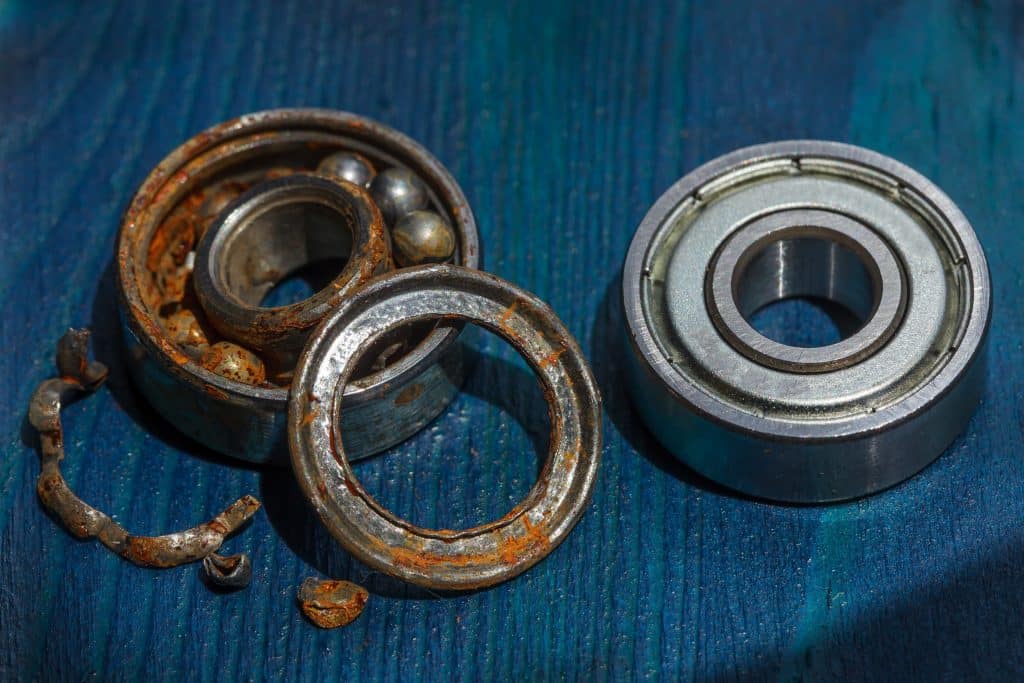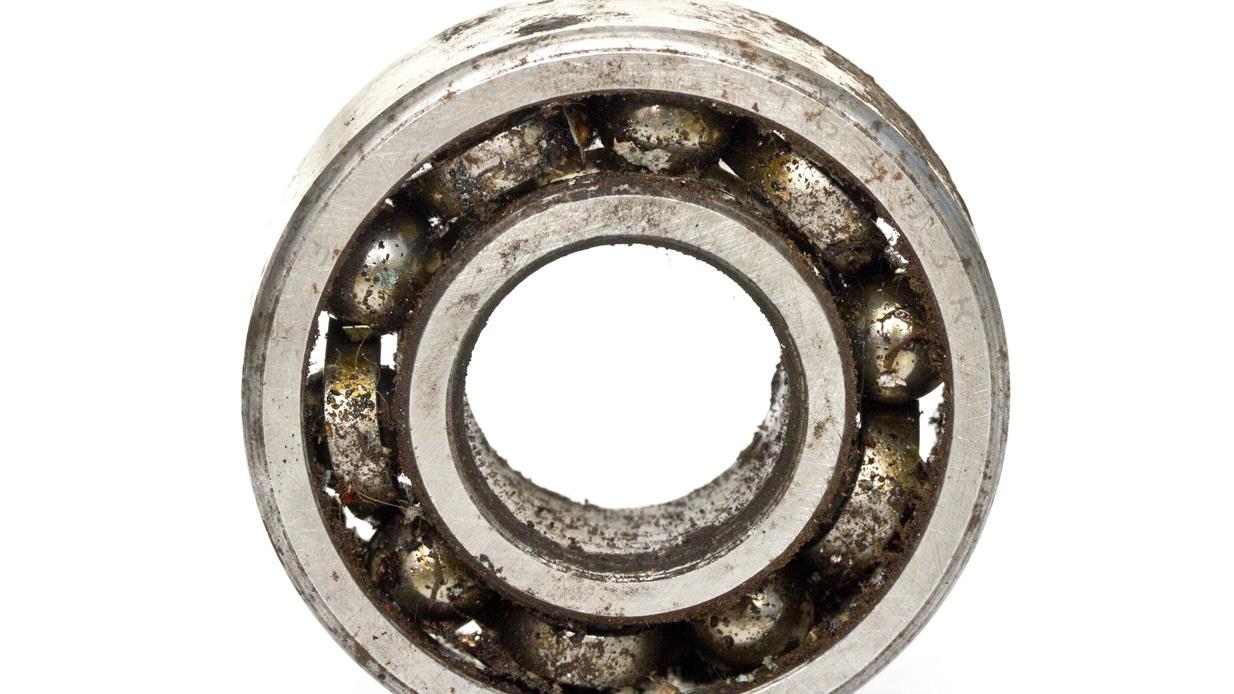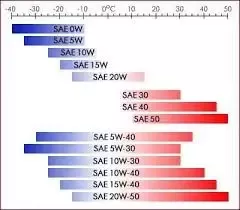Over greasing a bearing can lead to pressure build-up, causing overheating and potential seal failure. This can allow contaminants to enter and result in corrosion.
When a bearing is overfilled with grease, it can churn and push out excess grease, leading to energy loss and increased temperatures. Excessive pressure from over greasing can damage seals and cause premature bearing failure. To avoid these issues, it’s crucial to properly lubricate bearings to ensure optimal performance and longevity.
Understanding the symptoms and consequences of over greasing is essential for maintaining machinery efficiency and preventing costly repairs.

Credit: cbeuptime.com
The Perils Of Over-greasing
Over-greasing bearings might seem like a good idea to ensure proper lubrication, but it can lead to a host of problems. Adding excessive grease can result in heat build-up, seal failure, and ultimately, premature bearing failure.
The Domino Effect On Bearings
Excessive grease volume in a bearing cavity leads to the bearings churning the grease, causing energy loss and rising temperatures. This can lead to seal failure, allowing contaminants to enter and corrode the bearing components.
Heat Build-up: A Silent Destroyer
Over-greasing can cause excess heat build-up in the bearing cavity. This can damage the bearing seals, create cleaning issues, and increase downtime. The surplus grease may cause the rollers to slide instead of turn, leading to further complications.

Credit: www.youtube.com
Identifying Over-greasing Symptoms
Over-greasing bearings can lead to various issues that can affect the performance and longevity of the equipment. Identifying the symptoms of over-greasing is crucial in preventing potential damage and minimizing maintenance costs. Below are some common signs to look out for:
Bearing Overheating Signs
Excessive temperature rise: Over-greasing can lead to the generation of excess heat within the bearing, causing it to overheat. Unusual hot spots: When touching the bearing, if certain areas feel significantly hotter than others, it may indicate over-greasing. Discoloration: Inspect the bearing for any discoloration, as it can be a result of overheating due to excessive grease.
Seal Damage And Leakage Indicators
Visible grease leakage: Excessive grease can cause the seal to fail, leading to noticeable grease leakage around the bearing area. Presence of contaminants: Over-greasing can force contaminants, such as dirt and moisture, past the damaged seal, leading to their presence around the bearing. Corrosion: If the seal is damaged due to over-greasing, it can allow moisture to enter, leading to corrosion on the bearing surfaces.
Consequences Of Bearing Seal Failures
Contamination Ingress
Contamination Ingress: When bearing seals fail, dirt and moisture infiltrate, leading to corrosion.
Premature Wear And Tear
Premature Wear and Tear: Excessive pressure from over-greasing can cause seal failure and premature bearing leakage.
The Science Behind Lubrication Excess
Over-greasing a bearing can lead to various issues that affect the performance and longevity of the equipment. Understanding the science behind lubrication excess can help prevent potential problems and optimize the efficiency of bearing systems.
Churning Grease Dynamics
Excessive grease volume in a bearing cavity causes the rotating bearing elements to start churning the grease, leading to energy loss and rising temperatures. This churning action pushes the grease out of the way, resulting in inadequate lubrication and potential damage to the bearing components.
Pressure Pitfalls
Over-greasing generates high pressure inside the bearing, which can lead to seal failure and leakage. The excessive pressure may cause the seal to deteriorate, allowing dirt and moisture to infiltrate the bearing elements, leading to corrosion and premature failure.
Maintenance Missteps
Excessive greasing of bearings can lead to pressure buildup, causing the bearings to overheat and the seals to fail. This can allow dirt and moisture to enter, leading to corrosion and premature bearing failure. Avoid over-greasing to prevent these maintenance missteps.
Common Over-greasing Mistakes
Over-greasing bearings can lead to a host of problems that can affect the performance and longevity of the equipment. Here are some common mistakes to avoid when greasing bearings:
- Excessive Grease Volume: Adding too much grease to the bearing cavity can cause the rotating elements to churn the grease, leading to energy loss and rising temperatures.
- High Pressure: Over-greasing can generate excessive pressure within the bearing, potentially causing seal failure and leakage, ultimately resulting in premature bearing failure.
- Seal Damage: The excessive pressure from over-greasing can also cause the seal to fail, allowing dirt and moisture to enter the bearing, leading to corrosion.
- Heat Build-up: Surplus grease in the bearing cavity can cause the rollers or balls to slide instead of turning, resulting in excess heat build-up, which can damage the bearing and lead to increased downtime.
- Clean-up Issues: Over-greasing can cause the grease to overflow and create a mess, requiring additional clean-up efforts.
It is important to avoid these common over-greasing mistakes to prevent potential damage to the bearings and ensure optimal equipment performance.
Corrective Actions To Mitigate Damage
If you have already over-greased a bearing, it is essential to take corrective actions to mitigate the damage. Here are some steps you can take:
- Remove Excess Grease: Use a clean cloth or appropriate tools to remove the excess grease from the bearing cavity. Be careful not to introduce any contaminants during the process.
- Inspect for Damage: Carefully inspect the bearing for any signs of damage, such as seal failure or corrosion. If any damage is detected, consider replacing the bearing.
- Re-grease Properly: Follow the manufacturer’s guidelines for the appropriate amount of grease to be applied to the bearing. Ensure that you apply the correct type of grease and distribute it evenly within the bearing cavity.
- Monitor Performance: Regularly monitor the performance of the bearing to ensure that it operates within acceptable parameters. Keep an eye out for any abnormal heat, noise, or vibration.
- Establish a Greasing Schedule: Implement a regular greasing schedule based on the manufacturer’s recommendations to prevent over-greasing or under-greasing in the future.
By taking these corrective actions, you can minimize the damage caused by over-greasing and maintain the optimal performance of your bearings.

Credit: www.machinerylubrication.com
Best Practices In Bearing Lubrication
Proper lubrication is essential for the smooth and efficient operation of bearings. Over-greasing can lead to a range of problems, including excessive heat build-up, seal damage, and premature bearing failure. To ensure optimal performance and longevity of bearings, it is important to follow best practices in bearing lubrication. This involves careful grease selection and application techniques.
Grease Selection
Choosing the right grease for your bearings is crucial in preventing over-greasing and its associated problems. Consider the following factors when selecting grease:
- Operating conditions: Take into account the temperature, speed, and load conditions under which the bearings will operate. Different greases have varying temperature and viscosity ranges, so choose one that is suitable for your specific application.
- Thickener type: Greases are formulated with different types of thickeners, such as lithium, calcium, or polyurea. Each thickener has its own properties and compatibility with different bearing types. Consult the manufacturer’s guidelines or seek expert advice to select the appropriate thickener for your bearings.
- Base oil viscosity: The viscosity of the base oil affects the lubricating film thickness and the ability of the grease to flow and distribute within the bearing. Consider the speed and load requirements of your bearings to determine the optimal viscosity grade.
Application Techniques
Applying grease to bearings requires precision and care to avoid over-greasing. Follow these best practices for effective grease application:
- Quantity: Apply the recommended amount of grease as specified by the bearing manufacturer. Over-greasing can cause excess pressure and lead to grease leakage, seal failure, and increased temperatures.
- Frequency: Establish a regular maintenance schedule to ensure timely re-lubrication. This helps prevent dry running, which can result in bearing damage. However, avoid excessive re-lubrication intervals as it can lead to over-greasing.
- Method: Use appropriate grease application methods, such as manual greasing, automatic lubrication systems, or centralized lubrication systems. Each method has its advantages and considerations, so choose the one that suits your specific application and maintenance requirements.
- Proper distribution: Ensure that the grease is evenly distributed within the bearing. This can be achieved by rotating the bearing while applying the grease or using methods like sonic lubrication or ultrasonic greasing.
- Seal protection: Take care to prevent grease contamination and seal damage during application. Use suitable tools, such as grease guns with flexible hoses or fittings, to avoid direct contact between the grease gun and the seal.
By adhering to these best practices in bearing lubrication, you can prevent the problems associated with over-greasing and ensure optimal performance and longevity of your bearings.
Monitoring And Preventative Strategies
Monitoring and implementing preventative strategies for bearing lubrication is essential to prevent over-greasing issues and ensure optimal bearing performance. By adhering to proper lubrication schedules and utilizing appropriate grease application techniques, you can mitigate the risks associated with over-greasing and prolong the lifespan of your bearings.
Lubrication Schedules
Establishing and adhering to regular lubrication schedules is crucial for preventing over-greasing of bearings. By following manufacturer-recommended guidelines for lubrication intervals and quantities, you can avoid the detrimental effects of excessive grease accumulation.
Use Of Grease Guns And Meters
Utilizing grease guns and meters with precision and accuracy is paramount in preventing over-greasing problems. By employing calibrated grease guns and meters, you can ensure the correct amount of grease is applied to the bearings, minimizing the risk of over-lubrication.
Case Studies: Lessons Learned From Over-greasing
Lessons learned from over-greasing reveal symptoms of bearing problems. Excessive grease leads to high temperatures, seal failure, and potential corrosion risks. Understanding these signs helps prevent premature bearing failure and ensures optimal equipment performance.
Industrial Mishaps
Over-greasing bearings can lead to excessive pressure, causing bearings to overheat and seals to fail, allowing dirt and moisture inside, leading to corrosion.
Success Stories In Grease Management
Proper grease management prevents energy loss and rising temperatures due to overgreasing, avoiding premature bearing failure and downtime.
Frequently Asked Questions
What Problems Can Arise From Adding Too Much Grease To A Bearing?
Over-greasing a bearing can lead to several problems, such as increased pressure inside the bearing, which can cause the bearings to run hot and even fail. It can also lead to seal failure, allowing dirt and moisture inside the elements, leading to corrosion.
Additionally, excess grease can result in energy loss and rising temperatures due to churning of the grease by the rotating bearing elements.
What Does Excessive Grease Filling Of A Bearing Result In?
Excessive grease in a bearing causes pressure, leading to heat, seal failure, and potential corrosion from dirt and moisture.
Can Over Greasing A Bearing Cause It To Fail?
Over greasing a bearing can cause it to fail by building pressure, leading to heat and seal damage.
What Happens If There Is Too Much Lubricant?
Excess lubricant can lead to pressure build-up, causing the bearings to overheat and seals to fail, allowing contaminants inside.
Conclusion
Over-greasing can lead to bearing problems such as excess heat, seal damage, and increased downtime. It can cause pressure build-up, leading to seal failure and the entry of dirt and moisture, resulting in corrosion. It’s crucial to follow proper greasing guidelines to ensure optimal bearing performance and longevity.


